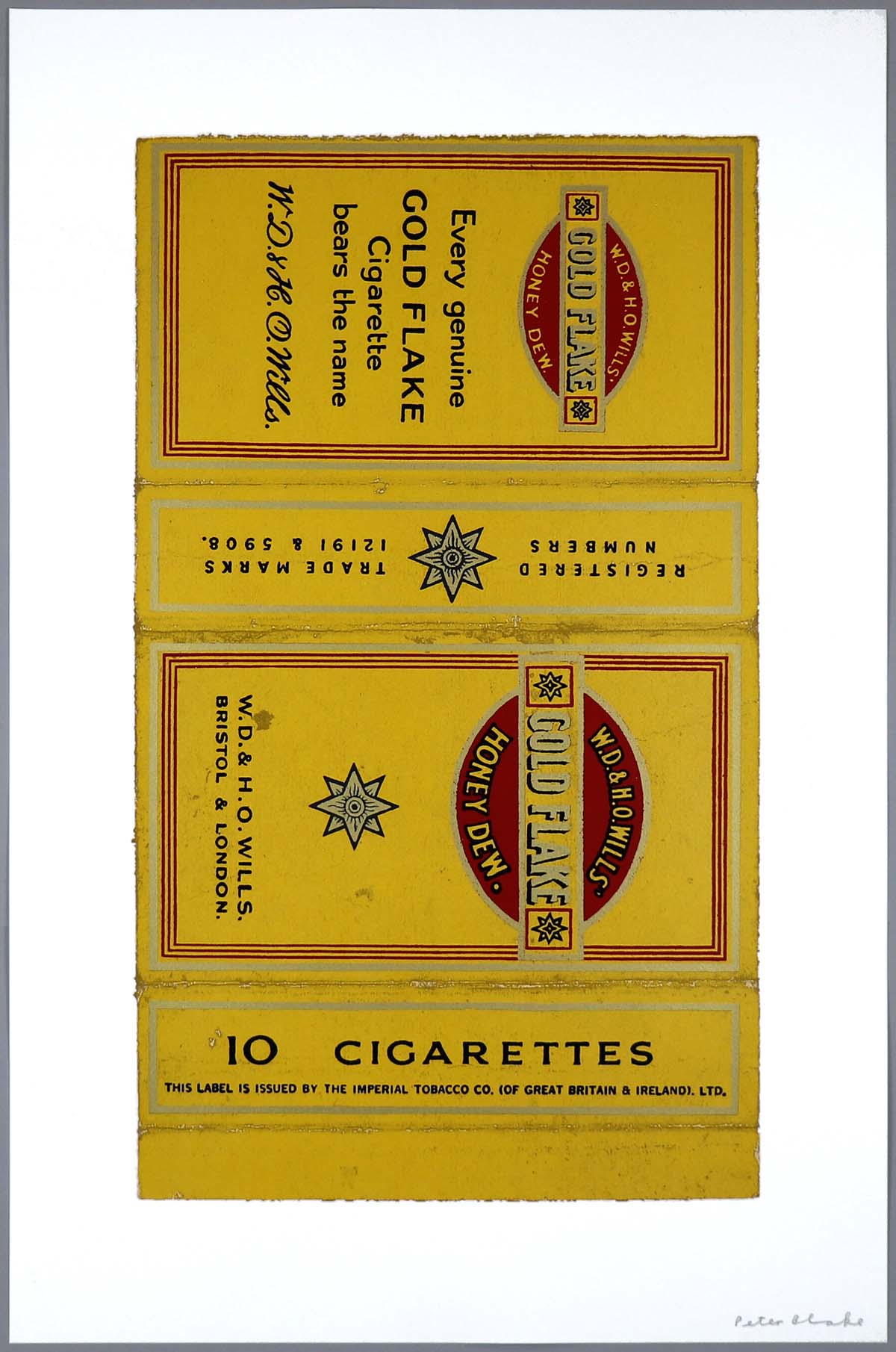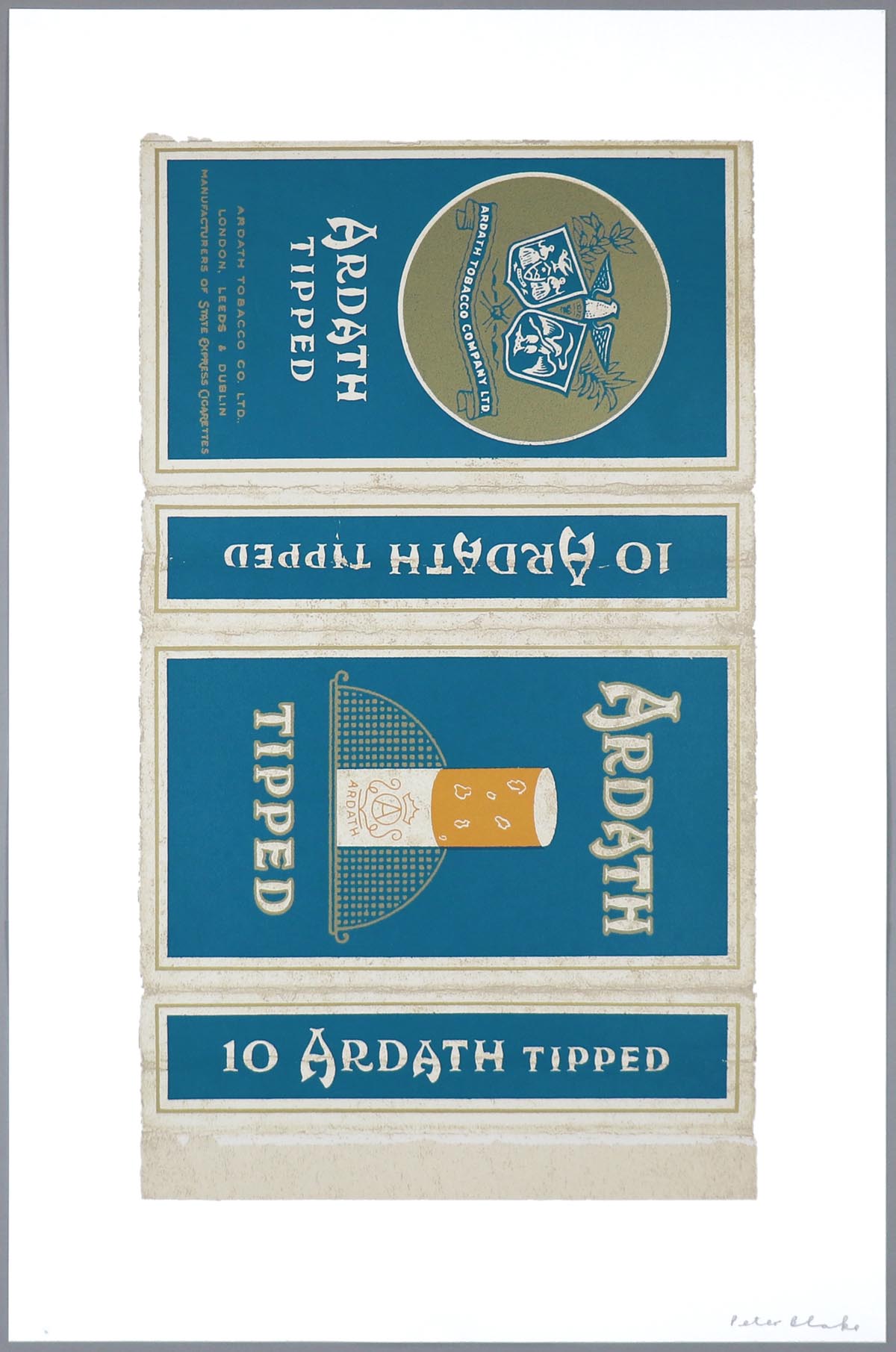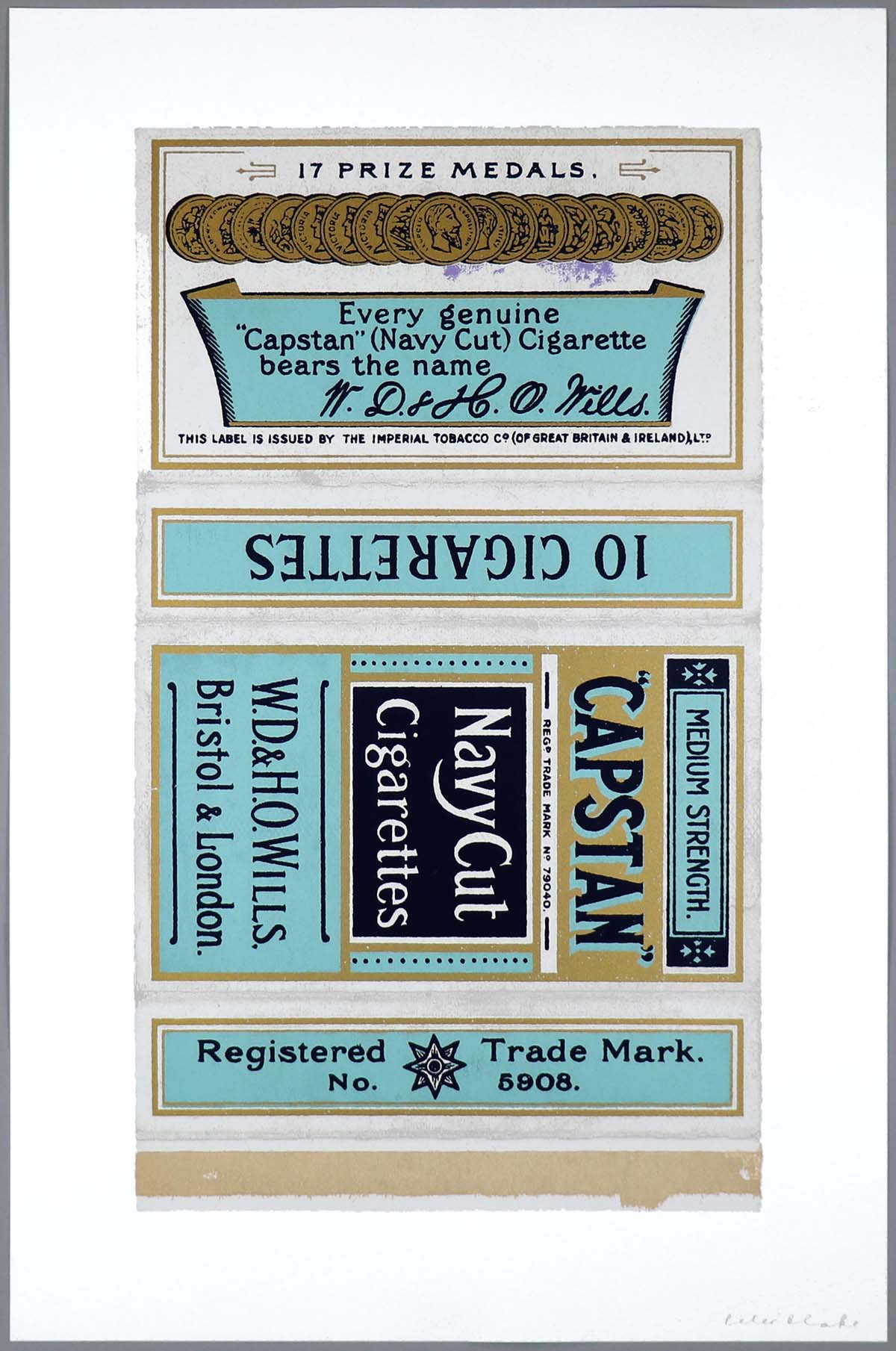Different sized ephemera have little by little found their way into every corner of Blake’s studio in London. Photographs, postcards, newspaper cut-outs, magazine ads, badges, leaflets, product covers and wriggled wrappings; each and every object a visual delight of flowingly curved lines, golden ratios and printed colour-blends that are meant to seduce a consumer and representing a better tomorrow. Too precious to discard, the fragments - big or small, neatly cut or torn - are sorted in a myriad of folders and boxes. What to some people is just a throw-away insignificance, has to the British artist always been an immeasurable treasure.
Blake’s lifelong passion for collecting imagery and items began as a teenager in Dartford, a small town twenty kilometres south-east of London. Growing up in aftermath of the war, the appeal of beautifully designed concepts - with promises of a brighter future and a happy lifestyle - served as an escapism to any young person at the time and a cue to what was achievable now. His talent for drawing and painting surfaced as an undergraduate at Gravesend Art School and later opened the doors to the Royal College of Art, where the artist graduated in ’56. It was during the graduate years in London that his techniques and unique approach developed into what is today clearly distinguishable.

PETER BLAKE
Gold Flake, 2006
Edition of 95
58(w) x 89(h) cm
22.83(w) x 35.04(h) inches

PETER BLAKE
Gold Flake, 2006
Edition of 95
58(w) x 89(h) cm
22.83(w) x 35.04(h) inches
|
|
|
58(w) x 89(h) cm
22.83(w) x 35.04(h) inches
|
Screenprint on Somerset satin paper.
Signed and numbered on front.
Edition of 95
|
|
The early paintings found inspiration from the American realism painters of the 20th century, such as Ben Shahn, Bernard Perlin and to some extend Grant Wood; the latter famous for his masterpiece ‘American Gothic’ (1930), showing a stern farmer holding a pitchfork, the wife on his right and the American wood farmhouse in the background. Just as Wood depicts an archetypical rural American couple, Blake parades British identity in his contemporary version, ‘ABC Minor’ (1955). In the painting, two school boys are caught standing in a moment of pretend innocence: brisk and rosy-eared in their uniform, wearing shorts and wrinkly white shirts, V-neck pullovers and a jacket. This is as British as it gets. Many cite the painted collage ‘On The Balcony’ (1955-57) as the moment Blake incorporate popular culture into his paintings, but it could be argued that the influx of pop was already present in the delightful ‘ABC Minor’ by the hip emblems on the boys jackets.
All the while Blake was still at the Royal College of Art, a wind of change was blowing on the other side of the Atlantic. In ’54, a twenty-four year old Jasper Johns looked to the Stars-and Stripes - an iconic object of the Western world - and starting painting it onto canvas; sometimes building several layers of stretched-up canvases on top of each other, as in ‘Three Flags’ (1958). This generation of New York artists simply picked up household brands and imagery in the public space, and elevated it into objects of art. In ’62, ‘Look Mickey’ (1961) by Roy Lichtenstein landed him a solo show at the legendary Manhattan art dealer, Leo Castelli, and when Warhol’s ‘Campbell Soup Cans’ the same year stole the cover of Time Magazine, the Pop Art movement was the new-new thing. The coming decade would produce some of today’s most recognisable artworks, but it wasn’t all plain sailing. To art dealers and gallerists many pieces were difficult to sell - rather too “uncomplicated” to be deemed as a work of art - and some works had a fleeting demeanour. When Warhol’s gallerist in Cologne, Rudolph Zwirner, was presented with the artist’s latest creativity, he found himself in a predicament: the tens of silver helium balloons, formed as clouds, were either constantly deflating or eager to join the real clouds outside the gallery door.

PETER BLAKE
Ardath, 2006
Edition of 95
58(w) x 89(h) cm
22.83(w) x 35.04(h) inches

PETER BLAKE
Ardath, 2006
Edition of 95
58(w) x 89(h) cm
22.83(w) x 35.04(h) inches
|
|
|
58(w) x 89(h) cm
22.83(w) x 35.04(h) inches
|
Screenprint on Somerset satin paper.
Signed and numbered on front.
Edition of 95
|
|
A few thousand miles from London, a young Eton graduate, Robert Fraser - working his way around the New York art scene - found the unstoppable new movement an opportunity not to be missed. He returned to London in the early sixties and opened a gallery that quickly grew to represent several promising artists. Blake, already identified with the Pop Art movement after he was included in the ‘Young Contemporaries’ exhibition in ’61 and featured in the film ‘Pop Goes the Easel’ in ’62, joined the ranks of Fraser which included Andy Warhol,
Ed Ruscha and Richard Hamilton.
At the first solo show at Fraser’s gallery in ’65, Blake was clearly influenced by everything ‘pop’ and for five weeks, fictious wrestlers and Kandy the stripper shared the gallery walls in Duke Street, with a painting of King Kong and The Beatles. Combined with Fraser’s ability to make himself a focal point in the Swinging London of the mid-sixties, the artist - through talent and network - became a frontrunner of British Pop. By the end of the sixties the swinging in London fizzled out, ending almost as quickly as it had started. The party was over and Blake decided to leave London by the allure of rural and picturesque Somerset. However, the obsession of youthful popular culture stayed with him and occasionally found its way into his works and commissions.

PETER BLAKE
Star, 2006
Edition of 95
58(w) x 89(h) cm
22.83(w) x 35.04(h) inches

PETER BLAKE
Star, 2006
Edition of 95
58(w) x 89(h) cm
22.83(w) x 35.04(h) inches
|
|
|
58(w) x 89(h) cm
22.83(w) x 35.04(h) inches
|
Screenprint on Somerset satin paper.
Signed and numbered on front.
Edition of 95
|
|
Thirty years later, Blake was back in London. Looking through boxes of old cigarette packets and flattening them out on the floor of the print studio in the outskirts of the capital, he instantly knew they would be a fantastic basis for a new series of work to kick off the new millennium. As well as an opportunity to catch up with an artistic old flame.
Ardath,
Belga,
Gold Flake,
Visa and many more empty packets epitomised the 20th century and the simple retro designs were perfect for transforming into works of art through a screen printing process. Placed on the naked floor, the ‘imperfections’ of each one - the folds and tears - all added to the authenticity of his concept. Every crumbled corner and edge tells a story, stimulating thoughts about how these imperfections came about. Who had first bought the packet? and in whose pocket or handbag had it “lived” during its short existence? Perhaps the contents of the packet had been resting softly between the lips of a glitzy woman and a witness to the twenties in Paris; or merely been in Blake’s own pocket, as he wandered the streets of London forty years later.
Whether these iconic design are familiar to the viewer or not, the series of Fag Packets from 2005 and 2006 are an example of how Blake utilises everyday objects that are often considered insignificant and make them the subject of his art, giving them another life and encouraging viewers to consider them in a completely different context.

PETER BLAKE
Capstan, 2006
Edition of 95
58(w) x 89(h) cm
22.83(w) x 35.04(h) inches

PETER BLAKE
Capstan, 2006
Edition of 95
58(w) x 89(h) cm
22.83(w) x 35.04(h) inches
|
|
|
58(w) x 89(h) cm
22.83(w) x 35.04(h) inches
|
Screenprint on Somerset satin paper.
Signed and numbered on front.
Edition of 95
|
|
The works by
Peter Blake are present in every major collection; from the Ludwig Museum in Cologne - its founder of one of the most important post-war collectors in Europe - to MoMA, New York, and Tate Modern, London. Accepted for the summer exhibition at Royal Academy in 1954 and 1955, and awarded First Price in the Junior Section at John Moores in 1961, the artist’s work have been widely exhibited throughout his career, including three retrospectives at Tate and one at The National Gallery. For decades, he has inspired younger generations of artists in Britain, just as Blake himself were highly influenced by the American pop artists of the fifties and sixties. Today, Blake works and lives in London.
Together, the six screen prints from 2005 - followed by four in 2006 - form two series of ‘Fag Packets’ which have become amongst the most popular print editions released by Eyestorm in the past twenty years. The opportunity to work closely with
Peter Blake at a time when he was already an established artist was a rare privilege and one that validated the gallery’s contribution to multiples. Each edition of 95 is a multi-layered screenprint on Somerset Satin paper with varnish highlights, signed and numbered in pencil on front.
To view the print editions in further detail and to find more information about available works by
Peter Blake, visit the artist’s page
here.